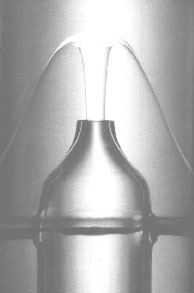We reach more than 65,000 registered users in Dec!! Register Now

Strange but True: Superfluid Helium Can Climb Walls
- November 13, 2013
- 1086 Views
- 0 Likes
- 0 Comment
Suppose in a scorching summer day, you are drinking some cold drinks. Suddenly, your cold drink starts leaking through the glass or starts climbing climbing up through the glass walls. How do you fell then? Won't it be really scary? Superfluids do exactly the same thing.†Superfluidity†is a†state of matter†in which the†matter†behaves ...
Suppose in a scorching summer day, you are drinking some cold drinks. Suddenly, your cold drink starts leaking through the glass or starts climbing climbing up through the glass walls. How do you fell then? Won't it be really scary?
Superfluids do exactly the same thing.†Superfluidity¬†is a¬†state of matter¬†in which the¬†matter¬†behaves like a fluid with zero¬†viscosity; where it appears to exhibit the ability to self-propel and travel in a way that defies the forces ofgravity¬†and¬†surface tension. While this characteristic was originally discovered in¬†liquid helium, it is also found in astrophysics, high-energy physics, and theories of¬†quantum gravity. The phenomenon is related to the¬†Bose¬ĖEinstein condensation, but it is not identical: not all Bose-Einstein condensates can be regarded as superfluids, and not all superfluids are Bose¬ĖEinstein condensates.

Superfluidity in Liquid Helium
In liquid helium, the superfluidity effect was discovered by Pyotr Kapitsa and John F. Allen. It has since been described through phenomenological and microscopic theories. In liquid helium-4, the superfluidity occurs at far higher temperatures than it does in helium-3. Each atom of helium-4 is a boson particle, by virtue of its zero spin. A helium-3 atom, however, is a fermion particle; it can form bosons only by pairing with itself at much lower temperatures. This process is similar to the electron pairing in superconductivity.
![fountain_1[1]](http://machprinciple.com/wp-content/uploads/2013/11/fountain_11.jpg)
Superfluid in astrophysics
The idea that superfluidity exists inside neutron stars was first proposed by Arkady Migdal. By analogy with electrons inside superconductorsforming Cooper pairs due to electron-lattice interaction, it is expected that nucleons in a neutron star at sufficiently high density and low temperature can also form Cooper pairs due to the long-range attractive nuclear force and lead to superfluidity and superconductivity.









